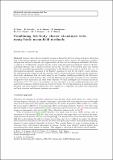Por favor, use este identificador para citar o enlazar a este item:
http://hdl.handle.net/10261/160466COMPARTIR / EXPORTAR:
 SHARE SHARE
 CORE
BASE CORE
BASE
|
|
| Visualizar otros formatos: MARC | Dublin Core | RDF | ORE | MODS | METS | DIDL | DATACITE | |

| Campo DC | Valor | Lengua/Idioma |
|---|---|---|
| dc.contributor.author | Hove, D. | - |
| dc.contributor.author | Garrido, Eduardo | - |
| dc.contributor.author | Jensen, A.S. | - |
| dc.contributor.author | Sarriguren, Pedro | - |
| dc.contributor.author | Fynbo, H.O.U. | - |
| dc.contributor.author | Fedorov, D.V. | - |
| dc.contributor.author | Zinner, N. T. | - |
| dc.date.accessioned | 2018-02-12T09:49:26Z | - |
| dc.date.available | 2018-02-12T09:49:26Z | - |
| dc.date.issued | 2017-01-12 | - |
| dc.identifier | doi: 10.1007/s00601-017-1216-3 | - |
| dc.identifier | issn: 0177-7963 | - |
| dc.identifier.citation | Few-Body Systems 58: 2 (2017) | - |
| dc.identifier.uri | http://hdl.handle.net/10261/160466 | - |
| dc.description | 4 pags., 2 figs. -- This article belongs to the Topical Collection “The 23rd European Conference on Few-Body Problems in Physics”. | - |
| dc.description.abstract | Nuclear cluster physics implicitly assumes a distinction between groups of degrees-of-freedom, that is the (frozen) intrinsic and (explicitly treated) relative cluster motion. We formulate a realistic and practical method to describe the coupled motion of these two sets of degrees-of-freedom. We derive a coupled set of differential equations for the system using the phenomenologically adjusted effective in-medium Skyrme type of nucleon-nucleon interaction. We select a two-nucleon plus core system where the mean-field approximation corresponding to the Skyrme interaction is used for the core. A hyperspherical adiabatic expansion of the Faddeev equations is used for the relative cluster motion. We shall specifically compare both the structure and the decay mechanism found from the traditional three-body calculations with the result using the new boundary condition provided by the full microscopic structure at small distance. The extended Hilbert space guaranties an improved wave function compared to both mean-field and three-body solutions. We shall investigate the structures and decay mechanism of C (C+n+n). In conclusion, we have developed a method combining nuclear few- and many-body techniques without losing the descriptive power of each approximation at medium-to-large distances and small distances respectively. The coupled set of equations are solved self-consistently, and both structure and dynamic evolution are studied. | - |
| dc.publisher | Springer Nature | - |
| dc.relation.isversionof | Preprint | - |
| dc.rights | openAccess | - |
| dc.title | Combining Few-Body Cluster Structures with Many-Body Mean-Field Methods | - |
| dc.type | artículo | - |
| dc.identifier.doi | 10.1007/s00601-017-1216-3 | - |
| dc.relation.publisherversion | http://doi.org/10.1007/s00601-017-1216-3 | - |
| dc.date.updated | 2018-02-12T09:49:26Z | - |
| dc.description.version | Peer Reviewed | - |
| dc.language.rfc3066 | eng | - |
| dc.relation.csic | Sí | - |
| dc.type.coar | http://purl.org/coar/resource_type/c_6501 | es_ES |
| item.openairecristype | http://purl.org/coar/resource_type/c_18cf | - |
| item.fulltext | With Fulltext | - |
| item.cerifentitytype | Publications | - |
| item.openairetype | artículo | - |
| item.grantfulltext | open | - |
| Aparece en las colecciones: | (CFMAC-IEM) Artículos | |
Ficheros en este ítem:
| Fichero | Descripción | Tamaño | Formato | |
|---|---|---|---|---|
| Combining few-body.pdf | 653,15 kB | Adobe PDF |  Visualizar/Abrir |
CORE Recommender
SCOPUSTM
Citations
3
checked on 13-abr-2024
Page view(s)
325
checked on 17-abr-2024
Download(s)
206
checked on 17-abr-2024
Google ScholarTM
Check
Altmetric
Altmetric
NOTA: Los ítems de Digital.CSIC están protegidos por copyright, con todos los derechos reservados, a menos que se indique lo contrario.
